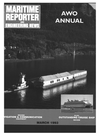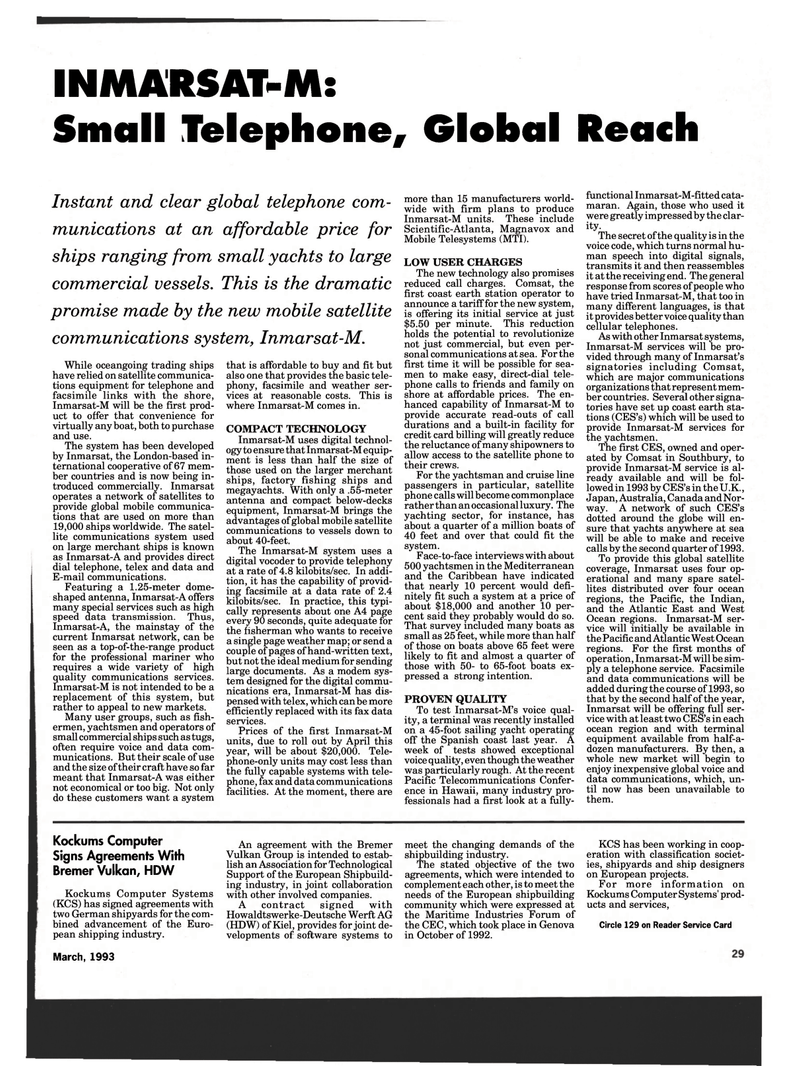
Page 27: of Maritime Reporter Magazine (March 1993)
Read this page in Pdf, Flash or Html5 edition of March 1993 Maritime Reporter Magazine
INMARSAT-M:
Small Telephone, Global Reach
Instant and clear global telephone com- munications at an affordable price for ships ranging from small yachts to large commercial vessels. This is the dramatic promise made by the new mobile satellite communications system, Inmarsat-M.
While oceangoing trading ships have relied on satellite communica- tions equipment for telephone and facsimile links with the shore,
Inmarsat-M will be the first prod- uct to offer that convenience for virtually any boat, both to purchase and use.
The system has been developed by Inmarsat, the London-based in- ternational cooperative of 67 mem- ber countries and is now being in- troduced commercially. Inmarsat operates a network of satellites to provide global mobile communica- tions that are used on more than 19,000 ships worldwide. The satel- lite communications system used on large merchant ships is known as Inmarsat-A and provides direct dial telephone, telex and data and
E-mail communications.
Featuring a 1.25-meter dome- shaped antenna, Inmarsat-A offers many special services such as high speed data transmission. Thus,
Inmarsat-A, the mainstay of the current Inmarsat network, can be seen as a top-of-the-range product for the professional mariner who requires a wide variety of high quality communications services.
Inmarsat-M is not intended to be a replacement of this system, but rather to appeal to new markets.
Many user groups, such as fish- ermen, yachtsmen and operators of small commercial ships such as tugs, often require voice and data com- munications. But their scale of use and the size of their craft have so far meant that Inmarsat-A was either not economical or too big. Not only do these customers want a system that is affordable to buy and fit but also one that provides the basic tele- phony, facsimile and weather ser- vices at reasonable costs. This is where Inmarsat-M comes in.
COMPACT TECHNOLOGY
Inmarsat-M uses digital technol- ogy to ensure that Inmarsat-M equip- ment is less than half the size of those used on the larger merchant ships, factory fishing ships and megayachts. With only a .55-meter antenna and compact below-decks equipment, Inmarsat-M brings the advantages of global mobile satellite communications to vessels down to about 40-feet.
The Inmarsat-M system uses a digital vocoder to provide telephony at a rate of 4.8 kilobits/sec. In addi- tion, it has the capability of provid- ing facsimile at a data rate of 2.4 kilobits/sec. In practice, this typi- cally represents about one A4 page every 90 seconds, quite adequate for the fisherman who wants to receive a single page weather map; or send a couple of pages of hand-written text, but not the ideal medium for sending large documents. As a modem sys- tem designed for the digital commu- nications era, Inmarsat-M has dis- pensed with telex, which can be more efficiently replaced with its fax data services.
Prices of the first Inmarsat-M units, due to roll out by April this year, will be about $20,000. Tele- phone-only units may cost less than the fully capable systems with tele- phone, fax and data communications facilities. At the moment, there are more than 15 manufacturers world- wide with firm plans to produce
Inmarsat-M units. These include
Scientific-Atlanta, Magnavox and
Mobile Telesystems (MTI).
LOW USER CHARGES
The new technology also promises reduced call charges. Comsat, the first coast earth station operator to announce a tariff for the new system, is offering its initial service at just $5.50 per minute. This reduction holds the potential to revolutionize not just commercial, but even per- sonal communications at sea. For the first time it will be possible for sea- men to make easy, direct-dial tele- phone calls to friends and family on shore at affordable prices. The en- hanced capability of Inmarsat-M to provide accurate read-outs of call durations and a built-in facility for credit card billing will greatly reduce the reluctance of many shipowners to allow access to the satellite phone to their crews.
For the yachtsman and cruise line passengers in particular, satellite phone calls will become commonplace rather than an occasional luxury. The yachting sector, for instance, has about a quarter of a million boats of 40 feet and over that could fit the system.
Face-to-face interviews with about 500 yachtsmen in the Mediterranean and the Caribbean have indicated that nearly 10 percent would defi- nitely fit such a system at a price of about $18,000 and another 10 per- cent said they probably would do so.
That survey included many boats as small as 25 feet, while more than half of those on boats above 65 feet were likely to fit and almost a quarter of those with 50- to 65-foot boats ex- pressed a strong intention.
PROVEN QUALITY
To test Inmarsat-M's voice qual- ity, a terminal was recently installed on a 45-foot sailing yacht operating off the Spanish coast last year. A week of tests showed exceptional voice quality, even though the weather was particularly rough. At the recent
Pacific Telecommunications Confer- ence in Hawaii, many industry pro- fessionals had a first look at a fully- functional Inmarsat-M-fitted cata- maran. Again, those who used it were greatly impressed by the clar- ity.
The secret of the quality is in the voice code, which turns normal hu- man speech into digital signals, transmits it and then reassembles it at the receiving end. The general response from scores of people who have tried Inmarsat-M, that too in many different languages, is that it provides better voice quality than cellular telephones.
As with other Inmarsat systems,
Inmarsat-M services will be pro- vided through many of Inmarsat's signatories including Comsat, which are major communications organizations that represent mem- ber countries. Several other signa- tories have set up coast earth sta- tions (CES's) which will be used to provide Inmarsat-M services for the yachtsmen.
The first CES, owned and oper- ated by Comsat in Southbury, to provide Inmarsat-M service is al- ready available and will be fol- lowed in 1993 by CES's in the U.K.,
Japan, Australia, Canada and Nor- way. A network of such CES's dotted around the globe will en- sure that yachts anywhere at sea will be able to make and receive calls by the second quarter of 1993.
To provide this global satellite coverage, Inmarsat uses four op- erational and many spare satel- lites distributed over four ocean regions, the Pacific, the Indian, and the Atlantic East and West
Ocean regions. Inmarsat-M ser- vice will initially be available in the Pacific and Atlantic West Ocean regions. For the first months of operation, Inmarsat-M will be sim- ply a telephone service. Facsimile and data communications will be added during the course of 1993, so that by the second half of the year,
Inmarsat will be offering full ser- vice with at least two CES's in each ocean region and with terminal equipment available from half-a- dozen manufacturers. By then, a whole new market will begin to enjoy inexpensive global voice and data communications, which, un- til now has been unavailable to them.
Kockums Computer
Signs Agreements With
Bremer Vulkan, HDW
Kockums Computer Systems (KCS) has signed agreements with two German shipyards for the com- bined advancement of the Euro- pean shipping industry.
March, 1993
An agreement with the Bremer
Vulkan Group is intended to estab- lish an Association for Technological
Support of the European Shipbuild- ing industry, in joint collaboration with other involved companies.
A contract signed with
Howaldtswerke-Deutsche Werft AG (HDW) of Kiel, provides for joint de- velopments of software systems to meet the changing demands of the shipbuilding industry.
The stated objective of the two agreements, which were intended to complement each other, is to meet the needs of the European shipbuilding community which were expressed at the Maritime Industries Forum of the CEC, which took place in Genova in October of 1992.
KCS has been working in coop- eration with classification societ- ies, shipyards and ship designers on European projects.
For more information on
Kockums Computer Systems' prod- ucts and services,
Circle 129 on Reader Service Card 101

 26
26

 28
28
